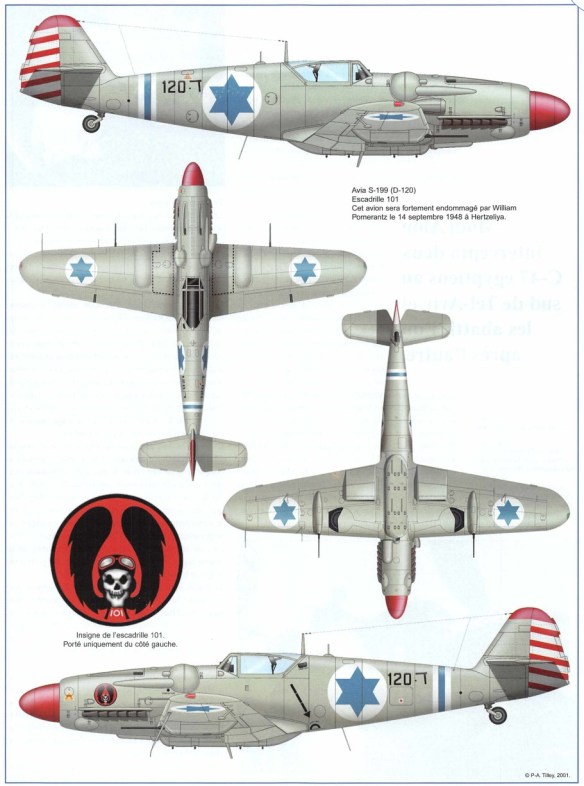The Czechs sold Israel twenty-five Avia S-199 (Me 109Gs assembled from parts left over after the war) called ‘Mezek’ or Mule by the Czechs but more often known as ‘Messer’ (knife in Yiddish) by their pilots.
In 1945, the Czech pilots returned home with their Spitfires and Lavochkins used in the war. These machines became the standard fighters in the first post-war years. There were also some planes left behind by the Luftwaffe. New planes were delivered by Avia. During the war, the company produced Messerchmitts Bf-109 for the Reich. The natural thing to do was continue with this production. There were, however, no original engines for the Bf-109 in the country. That’s why the engine was replaced by a heavier and more powerful type, which was plentiful. The plane was too nose heavy and the engine was overpowered for the design. The Avia designers did their best to improve the qualities of the plane, but this was only partly successful. The result was called Avia S-199, and its two-seater version was CS-199. The pilots called it “mezek” – a short form of Messerschmitt, but also the Czech expression for “the mule”, due to its mule-like behavior. The plane was difficult to balance, and had a tendency to roll over during the landing (this was a problem even with the original Bf-109). If this happened, the engineers had to smash the cabin with a long pole to get the helpless pilot out. When the pilot revved up the engine during the take-off, the movement was so strong that the plane was in danger of hitting the ground with the wing. In spite of these problems, hundreds of S-199’s were produced and used until 1955.
Israel used 25 S-199s from 1948 to 1949, and they played a critical role in defending the Jewish state against early Arab air raids. S-199s had a maximum speed of 368 mph and a ceiling of 28,500 feet. Range was 530 miles on internal fuel. Armament consisted of two 20-mm cannon and two 13-mm machine guns. The airplane weighed 6,305 pounds empty and 8,236 pounds loaded
The moment of glory for S-199 came with the Israeli war of independence. Czechoslovakia was the only country ready to equip Israel with aircraft and train their pilots. A number of Spitfires and Avias were delivered to Israel. Israeli pilots learned to use the excessive engine moment for unexpected sharp turns in combat. According to some sources, if it hadn’t been for Avias, there would be no Israel. It is ironic that the only Czech plane that played a decisive role in a real conflict was at the same time one of the worst Czech designs.
Ten Messerschmitt Avia S-199s, the Czech version of the German fighter, were purchased in Prague by Haganah agents on 23 April 1948. They were disassembled and, beginning on 21 May, shuttled in parts in an American Skymaster cargo plane to Israel, where Czech technicians hastily assembled them. By 29 May, four were ready for action. By the end of August, another fifteen had been added to what remained of the original ten. They constituted the backbone of the IAF. In general, and in contrast with the Spitfires, which arrived later, they performed poorly.
Gordon Levitt, Israeli fighter pilot, comparing the Spitfire, Mustang, and Avia S-199 (Jumo-engined Bf 109), all of which the Israelis flew: “Despite the pros and cons, the Spitfire was everyone’s first choice.”
In the 1948 Arab–Israeli War. The Egyptian army was about twenty miles from Tel Aviv, halted by a blown-up bridge, when four AVIA S-199 fighters (Czechoslovakian-built Me-109s that arrived in Israel and were assembled four days earlier) attacked them. An attack by such a small force is nothing dramatic. Damage on the ground was minimal, and one of the attackers was lost. But the Egyptians were shocked, since their intelligence had no inkling that the Israelis had real fighter planes and the Egyptian army had no antiaircraft weapons. Furthermore, the Egyptians were trained by the British and were an orderly force that operated by the book. They stopped to bring up AA weapons and so lost the momentum. This enabled the Israeli Southern Brigade to keep harassing them, stopping them for good and eventually defeating them.
